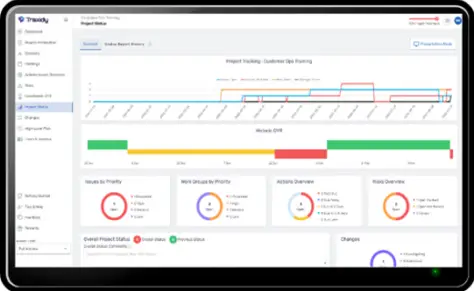
Project Status Reports: Time Wasted or Time Well Spent?

By: Steve McBroom, CEO, Traxidy
(Click to follow me on LinkedIn)
Project status reports provide a useful communication tool for multiple audiences on how your project is progressing. You may have to use the same template you’ve always used, or you may have started to deliver a new report based on a new template for a new audience or client. Either way, the project status report should always be judged by the value of the information versus the amount of time you may have spent to produce the report.
We have some important tips that will help you be more efficient and effective when producing and delivering project status reports.
Project Status Reports and Communication
Generally speaking, the main use of a project status report is to regularly communicate where we are with our project work to date, compared to the plan. The report implies “work” progress and the current status of the planned tasks, schedule and budget. Of course, many other aspects of the project can also be reported on including issues and action items and next steps.
This use of the draft status report, to obtain advice or get a second opinion, is an intelligent use of the information by the Project Manager.
Another use for a status report, is related to helping the Project Manager be more successful. The project status report can be a “discussion starter” between the Project Manager and their manager, the Project Management Office (PMO) or their project team. The Project Manager can provide a draft of the report, which indicates their opinion on aspects of the project, like overall status GYR (Green, Yellow or Red), the status of various areas of work, or their confidence in the project completing to plan. This use of the draft status report, to obtain advice or get a second opinion, is an intelligent use of the information by the Project Manager and results in more successful status meetings.
The project status report enables the Project Manager to report with confidence and show they are in control of the project and can predict future success.
A key step in the process is the project status report review. Don’t put a project status report in front of a sponsor or client, without a review. At least with a peer, but better with a senior manager or experienced person representing a PMO.
Provide ‘The Best’ Status Report Information
Some of your earliest meetings with your sponsor or client should include a discussion about the information they would like to see in the project status report, and how often they expect to receive the status update.
Some of your earliest meetings with your sponsor or client should include a discussion about the information in the project status report and how often they expect to receive one.
Your sponsor or client and other key stakeholders should be the ones to provide guidance on the information needed in the project status update. With your input and experience, give the “customer” what they want (within reason). Ensure your sponsor has agreed with the information and metrics that will be included in the Project Status Report, before the first one is presented.
A good project status report should be flexible, have a consistent format and be concise. As Project Managers, if you’ve been using the standard status report for some time now, and you find the sponsor is asking about specific aspects of the project in most status meetings, change the status report to include that aspect to better meet the needs of your sponsor and the project overall. If the template can’t be changed, add your own separate piece. Get out in front of what your sponsor has clearly let you know, they care about.
Accurate, timely and up-to-date information in the project status report, provides the best input to help make key decisions and to decide next best steps.
Judge Your Project Status Report by the Value vs. Effort Model
A project status report that involves multiple presentation slides and numerous pieces of data, and takes many hours of the Project Manager’s time to put together. This effort may appear to be useful if you go by the adage, “more data in the report makes it more valuable”, but this can also be problematic.
If you have to go looking into multiple places, like documents, notebooks, spreadsheets, emails, and more to obtain your information and data, then it could easily take half a day to pull all the information needed into a project status template. Every time you need to prepare for a status update meeting, your project status report is at least half a day behind, the minute you begin the meeting.
The report could be a waste of your time if the audience doesn’t see value in the report and if the Project Manager doesn’t receive any value, like guidance, advice, etc. from sharing it.
A report that can be completely automated and takes simply a few minutes to produce can help you save time and provide a professional and useful status report to keep everyone up to date on your project progress. However, the project information and update details must be relevant for your audience. If not, it could be a waste of your time if the audience doesn’t see value in the report and if the Project Manager doesn’t receive any value, like guidance, advice, etc. from sharing it.
Show Key Indicators of Future Success
There are some key aspects of project work that when shown to the sponsor, imply that you are working the project properly and being completely transparent. The experienced sponsor will want to know you have done risk assessment and are managing risks for their project. They may want to see the current number of large risks that still have a potential to impact the project. The sponsor would also want to see that number diminish, as the project gets closer to completion. To ensure the status update is useful, add relevant information like the current total number of open action items that need to be completed to keep the project on plan, or actions currently overdue or coming up this week.
The experienced sponsor will want to know you have done risk assessment and are managing risks for their project.
As discussed in our other blog post, the trend of the overall project status and of other focus areas is another example of a key indicator of future project success.
Do We Really Need to Have a Project Status Meeting?
No. It depends. Maybe. The project appears to be going according to plan. Instead of having the project status meeting, perhaps you just want to send out the report and save everyone the time.
Better to have the meeting regardless of the current state of bliss.
The stage of the work, the project complexity and number of key stakeholders will usually dictate any chance of bypassing a project status meeting, simply because the project appears to be on plan. It may be prudent to ask the sponsor or your manager ahead of the meeting to review the information, and they can make the call, as to whether or not to have the scheduled project status meeting. More often than not however, a project status meeting with multiple stakeholders in attendance, typically drives some topical discussions and questions each time. Better to have the meeting regardless of the current state of bliss.
Conclusion
- Project status reports can be used by the Project Manager to start discussions and lead to more productive and successful project status meetings.
- The information in the project status report should be flexible to meet the needs of the sponsor and type of project.
- The Project Manager needs to work directly with the sponsor and key stakeholders to ensure the proper information is presented in the project status report.
With the Traxidy Project Manager App, you can easily create, communicate and share custom, professional and timely Project Status reports with key stakeholders and everyone who needs to see it. Save time with automated updates, easy-to-use templates with interactive charts.
Sign up for our Project Manager Insights
Be the first to receive our Traxidy Blog and Project Manager Insights right to your in-box.









